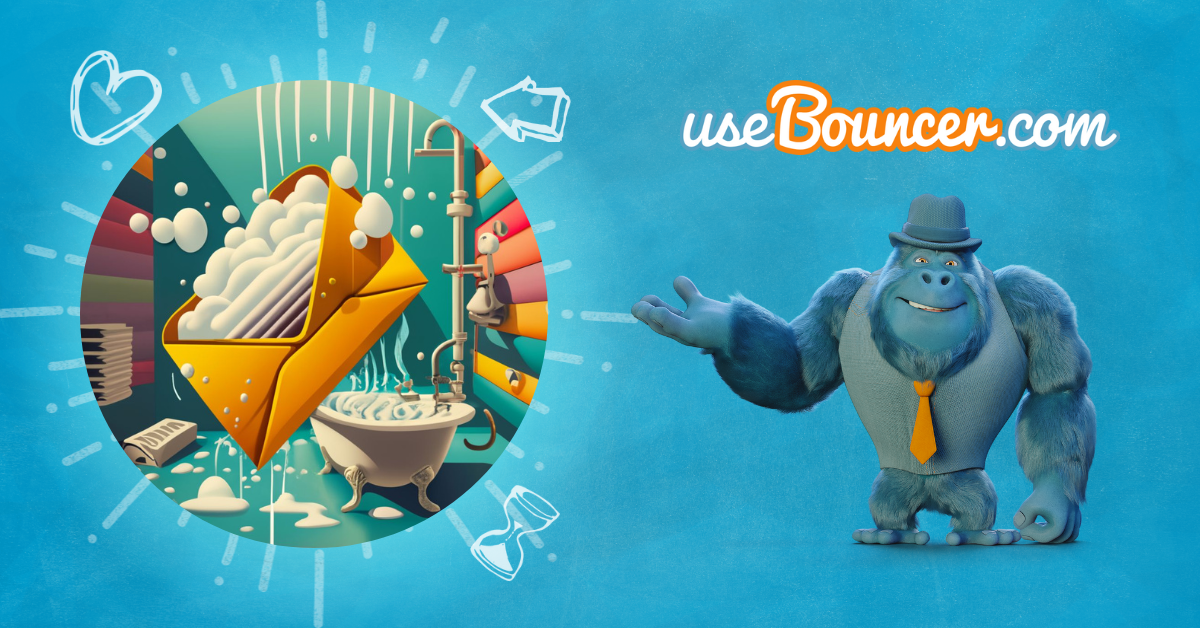How to Clean Email List in 11 Simple Steps
Cleaning your email list is the first step for maintaining the effectiveness of your email marketing campaigns.

You only need a few ways and straightforward steps, including automated list cleaning, to reach engaged and interested subscribers.
Yet, many marketers don’t do it, sending their emails in the void. That’s why, today, we’ve put the process altogether in 11 steps to show you how easy – and beneficial – it is to clean your email list, regularly.
Why Should You Even Bother Cleaning Your Email List?
1. Say Goodbye to Email Bounces
Ever wonder why some emails bounce back? It’s often due to outdated or invalid email addresses. Regularly cleaning your email list keeps it fresh and reduces these bounces. Think of it like updating your phone contacts – you wouldn’t text a number that’s no longer in service, right?
The same goes for your email list.
2. Keep Your Email Reputation Solid
Here’s a heads-up: sending emails to invalid addresses or spam traps can make email providers like Gmail and Yahoo! frown upon your campaigns. They start seeing you as the boy who cried wolf – unreliable. Cleaning your list helps you maintain good standing with these providers, so that your emails actually reach people.
3. Boost Real Engagement
Let’s face it, sending emails to people who never open them is like talking to a wall. By removing inactive subscribers, you’re actually honing in on folks who are interested in what you have to say. This means better engagement, which is what email marketing is all about, right?
4. Dodge the Spam Folder
Spam complaints are a big no-no. They can land your emails straight in the spam folder, unseen and forgotten. Cleaning your list helps you avoid sending emails to people who are likely to mark them as spam. It’s like avoiding that one neighbor who always complains – better for everyone.
5. Make Automation Work Smarter
If you’re using marketing automation (and you should be), a clean list ensures you’re not wasting efforts on the wrong crowd. It’s like throwing a party and making sure the invites go to people who actually want to come. More effective automation means better results with less effort.
6. Spend Wisely
Think about it: every email sent to a non-existent or uninterested person is a waste of money. Cleaning your list means your budget is spent on reaching people who might actually click through and convert. It’s like investing in stocks (after using a 409A valuation service) – you want to put your money where you’ll see returns.
7. Stay Updated with Email Providers
Email providers like Gmail and Yahoo! are constantly updating their authentication processes. By keeping your list clean, you’re also staying on top of these updates. It’s like keeping your software updated – you’re ensuring everything runs smoothly and your emails don’t end up in the digital void.
What Happens If You Don’t Clean Your Email List of Outdated Email Addresses
1. Increased Email Bounce Rates
Not cleaning your email list leads to sending messages to invalid email addresses. This results in high bounce rates. Email service providers notice this. They might think you’re not maintaining your list well. This can hurt your email deliverability. Keeping your list clean with an email list cleaning tool ensures you’re only sending emails to valid addresses. This keeps bounce rates low and your campaigns effective.
2. Damage to Sender Reputation
Your sender reputation is crucial. It’s how email providers judge if your emails should reach the inbox or the spam folder. Sending emails to outdated or duplicate email addresses can trigger spam complaints. This damages your reputation. Using an email verification service helps maintain a good reputation by ensuring your contacts are up-to-date.
3. Lower Engagement Rates
Outdated email lists mean you’re not reaching engaged subscribers. This can lead to lower open and click-through rates. It’s essential to re-engage inactive subscribers and remove unengaged ones. This helps improve the overall engagement of your email marketing campaigns, making them more effective.
4. Wasted Marketing Efforts
Sending emails to non-existent or uninterested contacts wastes your marketing efforts. It’s like talking to a wall. You’re not reaching people who are interested in what you have to say. Cleaning your email list ensures your messages reach subscribers who are genuinely interested in your content, making your marketing efforts more efficient.
5. Increased Costs
Most email marketing tools charge based on the number of subscribers. Keeping invalid email addresses or duplicate email addresses on your list means you’re paying more for less. Regularly using an email list cleaning service can help reduce costs by keeping your list lean and focused on subscribers who add value to your marketing campaigns.
6. Risk of Being Blacklisted
Internet service providers and email servers keep an eye on sources of spam emails. If your email list contains spam email addresses or you’re hitting too many invalid subscribers, you risk being blacklisted. This can severely impact your email deliverability. Regular list cleaning helps minimize this risk by removing problematic addresses from your contact lists.
7. Difficulty in Measuring Campaign Success
An outdated email list makes it hard to accurately measure the success of your email campaigns. With invalid subscribers and disengaged contacts, your email metrics won’t reflect the true performance of your marketing efforts. Cleaning your list helps ensure that your data is accurate, allowing you to make informed decisions about your email marketing strategy.
How to Clean Your Email List in 11 Steps
1. Identify Inactive Subscribers and their Invalid Email Addresses
Cleaning your email list starts with pinpointing those inactive subscribers. It’s like tidying up your room; you first spot what doesn’t belong. These inactive folks haven’t engaged with your emails for a while. They’re just taking up space, potentially harming your sender reputation and making your email marketing campaigns less effective.
Why does this matter? Well, email providers are watching. If too many of your emails end up ignored, in spam folders, or trigger spam complaints, they’ll start to question your credibility. This can hurt your inbox placement rates. Plus, inactive subscribers can skew your understanding of how well your campaigns are doing.
2. Remove Duplicate Email Addresses
Tackling duplicate email addresses is like weeding your garden; it’s essential for the health of your email list. Duplicates can sneak in through various channels—maybe a subscriber forgot they signed up and did it again, or perhaps your web forms didn’t catch the repeat entry.
These extra entries not only inflate your subscriber count but can also lead to sending multiple emails to the same person, which is a surefire way to annoy them and potentially increase your unsubscribe rates.
Active subscribers are the backbone of your email marketing efforts. By removing duplicates, you ensure your messages reach the right inboxes without overwhelming your audience. This careful management of your list respects your subscribers’ inboxes and preferences, leading to higher engagement and fewer unwanted emails marking your content as spam.
3. Verify Valid Email Addresses
Verifying valid email addresses is like checking the guest list at a party. You want to make sure everyone who gets an invite is supposed to be there. In the world of email marketing, sending messages to invalid addresses is a waste of effort and can hurt your reputation with email providers.
When you verify email addresses, you’re ensuring that each one on your list can receive your messages. This step is crucial because invalid addresses lead to hard bounces, a major red flag for email providers. They see it as a sign you might not be managing your list responsibly.
For new subscribers, implementing a system that verifies their email as they sign up can prevent invalid addresses from ever making it onto your list. This could be as simple as sending a confirmation email with an unsubscribe link, ensuring that only interested and valid subscribers join your list.
4. Unsubscribe Unengaged Contacts
Unsubscribing unengaged contacts is like pruning a tree – vital for healthy growth. In email marketing, this means letting go of subscribers who no longer interact with your content. It’s a necessary step to ensure your emails reach those genuinely interested.
Keeping unengaged subscribers can skew your engagement metrics and give you a false sense of how your campaigns are performing. More importantly, email providers pay attention to how recipients interact with your emails. A lack of engagement can signal to them that your content isn’t valued, potentially affecting your overall deliverability.
So, first, make it easy for subscribers to unsubscribe through clear unsubscribe links in your emails. This respects subscriber preferences and helps maintain a positive relationship with your audience, even as they exit.
Second, periodically review your email list for inactive contacts. Look for subscribers who haven’t opened or clicked through your emails in a significant amount of time. Before you remove them, consider sending a re-engagement campaign, based on past interactions. If there’s still no response, it’s time to remove inactive subscribers.
A non-obvious tip here would be to manage expectations. Be upfront about what subscribers can expect in terms of content and frequency. This clarity can help reduce the number of disengaged subscribers from the start.
5. Use Email Verification Tools
Using an email list cleaning tool helps a lot here. It sifts through your email database, separating the wheat from the chaff. This means you can focus your marketing efforts on engaged subscribers who are more likely to open, click, and convert. Remember, a clean email list leads to better click-through rates, fewer spam complaints, and a healthier email marketing strategy overall.
So, take the time to review your list. Remove those who haven’t opened an email in months. Consider a re-engagement campaign for those on the fence, maybe offer a free gift as an incentive.
But if they still don’t bite, it’s time to let them go. This way, your email campaigns reach the inboxes of those who truly value them, boosting your conversion rates and ensuring your marketing emails resonate with the most engaged subscribers.
Email list cleaning tools are here to save the day and automate many of these things for you and your business.
6. Delete Hard Bounce Emails
When an email hard bounces, it means the message couldn’t be delivered for permanent reasons, such as an invalid email address or a domain that no longer exists.
And hard bounces are a huge red flag to email providers. They indicate that you might not be keeping your list clean or up-to-date. If you have too many hard bounces, email providers might start to question the quality of your list and your credibility as a sender. Not ideal, is it?
The best approach is proactive management. After each campaign, take the time to review your bounce reports. Identify which emails hard bounced and delete them from your list immediately. This short activity keeps your list healthy so that you’re only sending emails to valid, active subscribers.
7. Segment Your Email List to Avoid Spam Complaints
Segmenting your email list is like organizing your contacts into different circles of friends. Each group has its own interests and preferences, and you talk to each group differently.
In email marketing, segmentation allows you to tailor your messages to match the specific interests and behaviors of your subscribers, leading to higher engagement and conversion rates.
Why segment? Well, not all subscribers are the same. Some might be new subscribers eager to learn more about your services, while others could be long-time customers. Sending the same message to everyone can lead to disengaged subscribers or, worse, hitting spam traps with irrelevant content.
Automation tools can help you segment your list based on subscriber actions, preferences, and engagement levels. This makes it easier to deliver personalized content that resonates with each segment.
Regularly review how different segments respond to your emails. Look at click-through rates and conversion rates to understand what works and what doesn’t. This data can help you refine your segments and improve your marketing efforts.
Customize your emails based on the segment. Use subject lines that speak directly to each group’s interests and craft content that addresses their specific needs and preferences.
8. Re-engage Inactive Subscribers
Re-engaging inactive subscribers is like reigniting an old friendship. It’s about reminding them why they connected with you in the first place and showing them what they’ve been missing out on. In the context of email marketing, this means reaching out to subscribers who haven’t interacted with your emails for a while but haven’t unsubscribed either.
Whether it’s exclusive content, a special discount, or a sneak peek at a new product, give them a reason to re-engage with your brand. A compelling offer can reignite their interest.
Automate your re-engagement campaigns to send after a subscriber has been inactive for a certain period. This ensures no one slips through the cracks.
Don’t forget about feedback loop. Include an option for subscribers to provide feedback or update their preferences. This can help you understand why they disengaged and how you can better meet their needs moving forward.
It’s more cost-effective to re-engage someone who has already shown interest in your brand than to acquire a new subscriber. Reducing the number of unengaged subscribers can improve your overall email engagement rates and sender reputation with email providers.
9. Implement Double Opt-In
Implementing double opt-in is a two-step process that not only verifies an email subscriber’s intent to join your list but also confirms their email address is valid and they have access to it. This practice is used for building a list of engaged and genuine subscribers.
Why is double opt-in important? First, it significantly reduces the chance of adding undeliverable addresses to your list.
When subscribers have to confirm their subscription, you automatically filter out those who provide incorrect email addresses intentionally or by mistake.
Make sure your initial opt-in message clearly states that the subscriber needs to confirm their email address to receive communications from you. This sets the right expectations from the start. Send the confirmation email immediately after the subscriber opts in. This takes advantage of their current engagement and interest.
Keep an eye on how your double opt-in process affects your sign-up rates and adjust as needed. Sometimes, tweaking the wording or design of your confirmation email can make a big difference.
10. Regularly Update Contact Lists
Regular updates help you avoid the pitfalls of duplicate email addresses, invalid addresses, and the accumulation of inactive subscribers, which can all hinder the effectiveness of your marketing efforts.
Why is this important? Well, over time, people change their email addresses, lose interest, or simply forget they subscribed.
If you’re not regularly updating your contact lists, you’re likely wasting resources on sending emails to recipients who will never engage with your content.
In addition to automated cleaning, manually review your lists periodically. Look for opportunities to segment your audience further or identify patterns that might indicate a need for updated strategies. This task might require some manual work and some time. Therefore, having an executive assistant who will help you with it might save you time and money.
11. Monitor Email Campaign Metrics
Monitoring your email campaign metrics is like keeping a pulse on the health of your marketing efforts.
Identify which metrics are most important for your goals. Common KPIs include open rates, click-through rates, conversion rates, and unsubscribe rates. These indicators can tell you a lot about your email subscribers’ behavior and preferences.
Then, leverage the analytics features of your email survey platform These platforms can provide detailed reports on your campaigns, invaluable for refining your email marketing strategy.
Don’t just look at metrics in isolation. Analyze them over time to identify trends or patterns. This can help you anticipate changes in subscriber behavior and adapt your strategies accordingly.
Be a Good Friend to Email Service Providers
Being a good friend to your email provider involves embracing a few best practices. Regularly clean your lists with automated tools, ensuring only relevant, engaged contacts remain. This not only keeps your campaigns efficient but also maintains a healthy relationship with providers, ensuring your emails consistently reach recipients’ inboxes. Adopt these habits, and watch your email marketing thrive.






